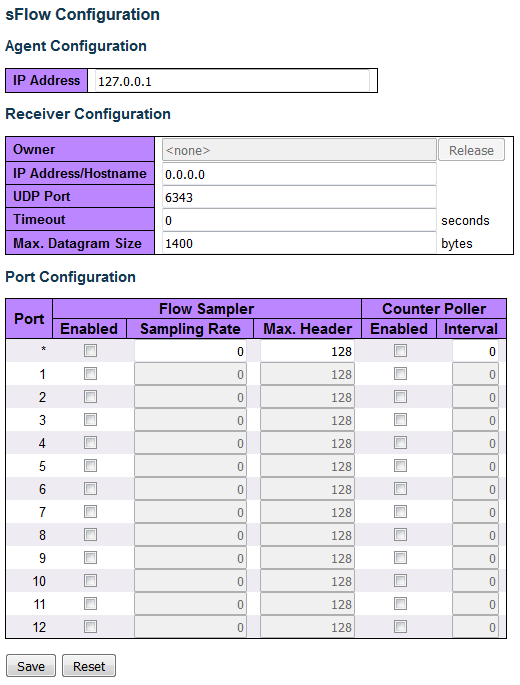sFlow
This page allows for configuring sFlow. The configuration is divided into two parts: Configuration of the sFlow receiver (a.k.a. sFlow collector) and configuration of per-port flow and counter samplers.
sFlow configuration is not persisted to non-volatile memory, which means that a reboot will disable sFlow sampling.

| Object | Description |
|---|---|
| Agent Configuration | |
| IP Address | The IP address used as Agent IP address in sFlow datagrams. It serves as a unique key that will identify this agent over extended periods of time. Both IPv4 and IPv6 addresses are supported. |
| Receiver Configuration | |
| Owner | sFlow can be configured in two ways: through local
management using the web or CLI interface, or through SNMP. This read-only field shows the owner of the current
sFlow configuration and assumes values as follows:
The Release button allows for releasing the current owner and disable sFlow sampling. The button is disabled if sFlow is currently unclaimed. If configured through SNMP, the release must be confirmed (a confirmation request will appear). |
| IP Address/Hostname | The IP address or hostname of the sFlow receiver. Both IPv4 and IPv6 addresses are supported. |
| UDP Port | The UDP port on which the sFlow receiver listens to sFlow datagrams. If set to 0 (zero), the default port (6343) is used. |
| Timeout | The number of seconds remaining before sampling stops and the current sFlow owner is released. While active, the current time left can be updated with a click on the Refresh-button. If locally managed, the timeout can be changed on the fly without affecting any other settings. |
| Max. Datagram Size | The maximum number of data bytes that can be sent in a single sample datagram. This should be set to a value that avoids fragmentation of the sFlow datagrams. Valid range is 200 – 1468 bytes. Deafult is 1400 bytes. |
| Port Configuration | |
| Port | The port number for which the configuration below applies. |
| Flow Sampler Enabled | Enables/disables flow sampling on this port. |
| Flow Sampler Sampling Rate | The statistical sampling rate for packet sampling. Set to N to sample on average 1/Nth of the packets transmitted/received on the port. Not all sampling rates are achievable. If an unsupported sampling rate is requested, the switch will automatically adjust it to the closest achievable. This will be reported back in this field. |
| Flow Sampler Max. Header | The maximum number of bytes that should be copied from a sampled packet to the sFlow datagram. Valid range is 14 to 200 bytes with default being 128 bytes. If the maximum datagram size does not take into account the maximum header size, samples may be dropped. |
| Counter Poller Enabled | Enables/disables counter polling on this port. |
| Counter Poller Interval | With counter polling enabled, this specifies the interval - in seconds - between counter poller samples. |
| Buttons | |
|---|---|
 |
Refresh the page immediately. Any non-committed changes will be lost. |
 |
Save changes. |
 |
Undo any changes and revert to previously saved values. |

